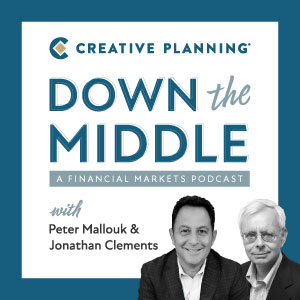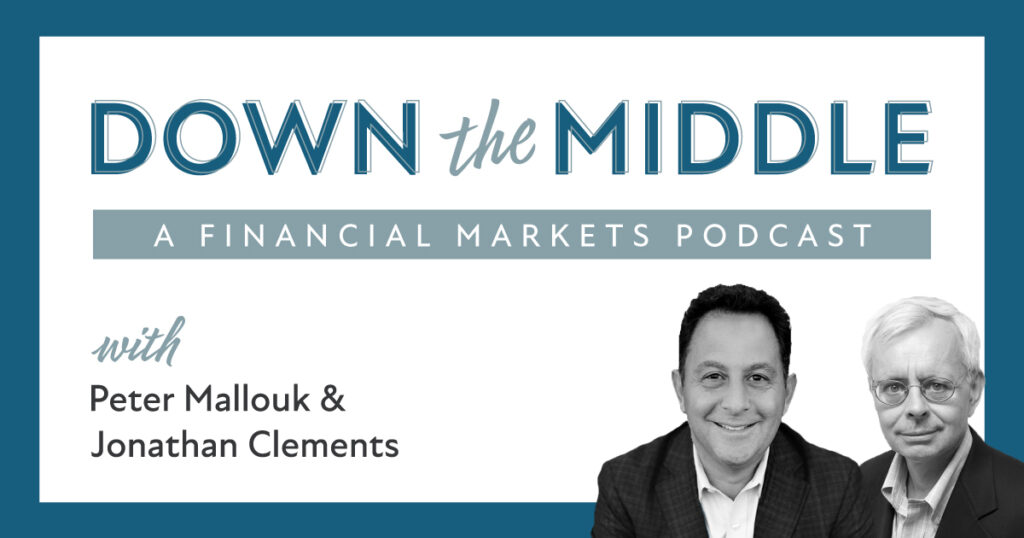With just two months left in 2024, time is limited to make important decisions affecting your tax bill, retirement contributions and more. Peter and Jonathan share the potential benefits of tax-loss harvesting, Roth conversions, donor-advised funds, flexible spending accounts and other key planning strategies to consider implementing before year-end. Plus, hear why bringing up financial topics with the family at Thanksgiving might not be such a bad idea after all.
Hosted by Creative Planning’s Director of Financial Education, Jonathan Clements, and President, Peter Mallouk, this podcast takes a closer look into topics that affect investors. Included are in-depth discussions on financial planning issues, the economy and the markets. Plus, you won’t want to miss each of their monthly tips!
Important Legal Disclosure:
creativeplanning.com/important-disclosure-information/
Have questions or topic suggestions?
Email us @ podcasts@creativeplanning.com
Transcript:
Jonathan Clements: This is Jonathan Clements, Director of Financial Education for Creative Planning. With me is Peter Mallouk, President of the firm, and we are Down the Middle. It’s two months until the end of the year. That means many of us are facing deadlines that, among other things, will affect our 2024 tax bill, how much we contribute to our employer’s retirement plan and what health insurance we’ll have in 2025. Peter, on this topic, there’s a lot we could potentially cover, but let’s start with taxes. What are the key items that listeners should be alert to?
Peter Mallouk: Well, there’s all kinds of things that come with a 12/31 deadline that people should consider. So, first, if you have any opportunities to take tax losses in your portfolio, take a look at the portfolio and make sure you don’t miss those opportunities. So with every investment you have, at some point in the future, there will probably be a moment when you will sell it. Unless you own it until you pass, when you sell it, you’re going to pay capital gains taxes. But if you have capital losses from things you sold at a loss in the past, you get to deduct those from the gains and escape some of those taxes.
So as an example, if you have Coca-Cola in your portfolio and it was down at some point through the year, you would want to sell it, replace it with something else, maybe go back to Cola-Cola after 31 days — you’re allowed to go back and buy it later — and put that loss on your tax return. So when you sell something at a gain in a future, you’ve got a loss to offset it. These capital losses from your portfolio also work against capital gains you might have from real estate or selling a business or something else. And so they’re kind of free passes, but you’ve got to do them before the end of the year for them to be able to count on this year’s tax return. Take another one that most people are aware of, but that can get away from people and has very stiff penalties if you don’t get it right, is taking your required minimum distributions. So if you’ve got an IRA, you’re of the age where you’re required to take distribution, make sure it happens.
And then for those that might have a low income tax year, either you’re a low income earner or you have an abnormally low income year, talk to your CPA, or Certified Financial Planner, about making a Roth conversion. It’s a little bit of a hassle, but it can make a lot of sense for certain people in certain situations. And then I know a lot of people own small businesses, you want to make sure that you look at the timing of your revenues and expenses. So if you’re looking at making certain bigger purchases than normal, it’s worth having a conversation with your tax advisor to say, “Should I be making them this calendar year? Will I get a bigger break this calendar year than I might next calendar year?” And really think about those. This is the time of year to be thinking about that if you’re a business owner too.
Jonathan: Well, another thing a lot of people think about toward the end of the year are charitable contributions. Have you got any wise suggestions on that front, Peter?
Peter: So this is a really great opportunity for people to impact their tax bills. So one is if you’ve made commitments to charities, let’s say you’re committed to a charity to give them $1,000 a year for the next 10 years, but let’s say you’re retiring in one year, so this is your last big income year, it may make sense for you to fulfill all of that gift this year when your deduction will be against the higher income tax bracket. So sometimes it makes sense to take giving that was going to happen over time and accelerate it. Of course, the opposite can be true. Maybe you’ve got a charity you want to help and you were thinking about giving the money this fourth quarter, but next year is your bigger income tax year, you’d be better off to give it to them in January. So consider the timing of your giving.
I think the biggest mistake people make with charitable giving is they give cash. 91% of charitable giving, as you know, Jonathan, comes in the form of cash. People write a check against their account. That’s actually the worst way to give. The best thing to give is an asset that has appreciated. So if you’ve made $1,000 commitment to a charity and you write them a $1,000 check, that’s wonderful. The charity gets $1,000 and you get a $1,000 income tax deduction, so maybe it costs you $700. But instead, you should be going to your portfolio or real estate or wherever you’ve got an appreciated asset, find the stock that went up the most and take $1,000 of that stock and give it to the charity. Now the charity still gets $1,000, you still get a $1,000 income tax deduction, but you’ve also not paid capital gains. When the charity sells that stock, they will not pay capital gains.
So you can then take the $1,000 in cash you were going to give to the charity, buy that stock again, and now your basis in the stock is $1,000. It’s not the lower amount you paid for the stock you gifted. Kind of a hard thing to explain without a piece of paper and a pen, but the simple way to look at it is if you have cash, you get a $1,000 income tax deduction. If you give stock, you’re escaping the capital gains tax you were going to pay, plus you’re getting the income tax deduction.
Jonathan: And just to bring the two ideas together, gifting appreciated stock and making a big gift in the year when you have high income, you could conceivably take that highly appreciated stock and use it to fund a donor-advised fund. They’re available from Schwab, Fidelity, Vanguard, and that way you can make the big contribution this year. But if you don’t want to give the money to the charity solely this year, you want to give it over time, you could fund that donor-advised fund and then make your $1,000 gift every year for the next 10 years. So that’s a way to achieve both goals and keep credit control over the gifts that are made.
Peter: Yeah. At Creative Planning, we’re huge fans of donor-advised funds. I am hazard to guess how many we have set up for clients. We always custody those at Schwab or Fidelity and use a third party to administer it. But it’s incredible really because to your point, if you were going to give $10,000 to a charity, now you’d probably need more money than that to set up and bother with the donor-advised fund, let’s put the threshold at around $50,000 for it to be worth it. But if you were going to make a gift to a charity over time, instead you make it all at once, you get the deduction this year, it sits in your donor-advised fund. And then from there it goes when you want.
The other hidden feature of donor-advised funds that comes into play with the tax planning that we’re talking about today is you don’t have to keep track of stuff. So if during a year you make $500, $200 gifts to 50 charities, you’ve got to save all these receipts and pile all this stuff up, get it to your CPA, and then something’s missing and it goes on forever. If instead you have, let’s just say $50,000 in a donor-advised fund and over the year you make a bunch of couple hundred dollars, couple thousand dollars gifts that use $10,000 of that, well, you don’t have to keep track of anything because you got the deduction when things went into the donor-advised fund, that was the charitable gift. The dispersions, you do not need to track. It is a godsend for a lot of people to give that way.
Jonathan: So another deadline that people are facing actually normally before year-end is their employers are having open enrollment for various benefits, most notably for health insurance. Any suggestions on that front, Peter?
Peter: Unfortunately, this is such a complicated area, it drives me cra — everything about health insurance is complicated, but some things to write down if these aren’t things you’re familiar with would be fund a flexible spending account. This is something where you get to use before tax dollars to pay for some medical expenses. You can open a high-deductible health plan with a health savings account. So again, you get to use dollars that will grow tax-free. They’ll come out for health expenses in the future. Some people don’t even use them for health expenses. It sort of becomes like a Roth IRA, it grows tax-free and passes to your beneficiary tax-free. Lots of opportunities around this sort of planning that come with an expiration date. Look at your employer’s options, these are employer-based. See what’s available to you, and to the extent you can afford it, I would make sure you take advantage of these things.
Jonathan: So one suggestion I have for listeners is when you look at health insurance, which can be really complicated to assess, is to pay attention to two numbers. First, the number most of us look at, which is what is our monthly premium going to be? Because that’s the minimum you’re going to pay throughout the year. If it’s a $300 monthly premium, that’s what you’re going to pay every month. But on top of that, look at what the out-of-pocket maximum is, which is the maximum you are going to pay throughout the year as long as you stay in network. And that’s a really important number because if you’re trying to think about the worst case scenario, which might drive, say, the size of your emergency fund, you want to put together those two numbers. What is going to be my monthly premium and what is going to be my out-of-pocket maximum? Combine those two numbers and you’ll know, as long as you stay in network, what you’re going to pay in a worst-case scenario out of pocket in 2025.
And what you may discover by looking at those two numbers is the plan that seems like it’s best, it’s a gold plan with a low deductible actually turns out to be potentially the most expensive because the out-of-pocket maximum is high and because the monthly premium is high. So I’d look at those two numbers, the out-of-pocket maximum and the monthly premium.
Peter: That’s excellent, excellent advice.
Jonathan: So, Peter, one final question for you. 2024 employees can contribute up to $23,000 to a 401k plan or $30,500 if they’re age 50 or older. Well, the deadline for funding an IRA is mid-April. Employees typically have to make their 401k contributions by the end of the year. So, Peter, isn’t making sure that you max out that 401k the easiest way to both save on taxes and also make sure you’re well-prepared for the future?
Peter: Yeah, there’s a big, big opportunity here we want to make sure nobody misses. Some people are fortunate enough to work at a place that has a 401k match, meaning when you put a dollar in, they might give you a dollar, just double your money instantly, or 50 cents or something. Find out what that match is and if at all possible, contribute at least up to the match. There’s not a single investment in the world that has a better guaranteed rate of return. So this is as good as it gets. If you’ve got a match at work, make sure you get to that level.
Beyond that, if you can contribute more, it’s wonderful because it’s money you contribute to the 401k you’re not going to pay income taxes on. So $10,000 that comes to you, you pay income taxes, $10,000 that goes in your 401k, you do not. It then grows tax-free and you’ll pay taxes way down the road when you take the money out at the earliest at around age 60, but most people when they’re 70 or older when it’s required to come out. So an incredible opportunity to not only not pay taxes, but to get a match in many cases.
Jonathan: All right, Peter, so we’re at that time of the podcast. It’s time for the tip of the month. What have you got for me this month?
Peter: So, at Creative Planning, we have so many people that have donor-advised funds. You and I talked about it in the tax planning component in two different ways, but what I see is most people set up donor-advised funds and then at some point they pass away and their kids don’t know what to do with those donor-advised funds. And so you know what they do? They do what they want. And many times what they want to do is not congruent with what the parents had in mind. I mean, they give to causes sometimes that are directly adverse to what the parents had in mind. And so just pick your issue, whether it’s pro-choice, pro-life, or guns, or whatever. All of these things that you can give to are 501(c)(3)s. Most of them are set up in a way where you can make a charitable distribution to those places.
So if you do have a donor-advised fund, or any kind of charitable fund at all in the family, I would suggest you have a mission statement or a value statement where you are outlining, “Here are the causes we are giving to, here are the things we believe in.” And better yet, when you’re doing your giving, if your kids are adults, and sometimes even if they’re not, have them at the table so they’re participating in that giving, it’s a wonderful way to bring the family together, to teach them your values and to have that continuity in the event of your passing. What’s your tip, Jonathan?
Jonathan: Well, actually, it meshes very well with yours, Peter. So in the month ahead, many of us are getting together with our parents or with our adult children because it’s going to be some Thanksgiving and it’s one of those chances throughout the year when we can actually sit down and talk face-to-face to our parents or to our adult children. And when you have any conversation, but particularly a financial conversation, it’s always better face-to-face than via text message or over the telephone. So I’m not saying you have to talk about this around the Thanksgiving table, but if there’s a financial topic you want to discuss with your kids or with your elderly parents, this is a great opportunity.
Tell them ahead of time what you want to talk about so they have a chance to prepare — you don’t want to spring it on them — and then make time the evening before Thanksgiving, before you sit down for the Turkey, whenever it is, to talk about these financial issues. Because in many cases, the greatest way to avoid conflict down the road is to talk about things early and often and make sure that there is no misunderstanding. So that’s my tip of the month, Peter. This is Jonathan Clements, I’m the Director of Financial Education for Creative Planning. I’ve been talking to Peter Mallouk, President of the firm, and we are Down the Middle.
Disclosure: This show is designed to be informational in nature and does not constitute investment advice. Different types of investments involve varying degrees of risk and there can be no assurance that the future performance of any specific investment or investment strategy, including those discussed on this show, will be profitable or equal any historical performance levels.





